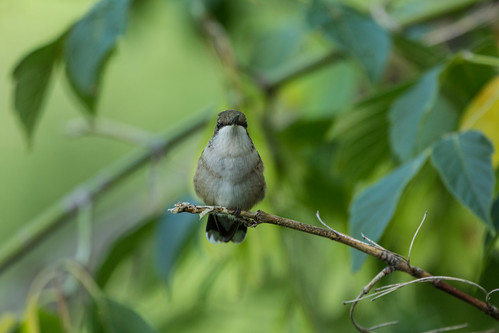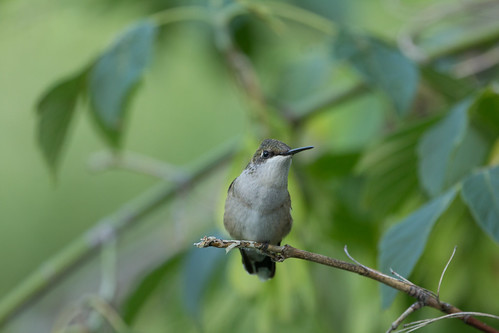 |
| All the photos shown in this blog entry were taken within 4 seconds when the bird was "resting" but looking every which way |
I’ve been a member of several professional ornithological societies since the 1970s, and love reading the scientific papers in their journals. Of course, some studies are stronger than others. When my children were babies, I often read journal articles aloud to them while I was nursing them or rocking them to sleep, and remember chuckling about the conclusions of one particular paper from 1985 claiming that hummingbirds do not have natural predators. The paper summarized the authors’ literature search in which they could find only 13 documented cases ever of hummingbird adults being taken by predators, and concluded that “hummingbirds in North America do not have ‘natural predators’ in the usual sense.”
Most of the studies I read in journals correspond to and
provide insights into my own observations, but not this one! I could see hummers
right outside my own window taking breaks after a stomach-filling drink. They
never tucked in their head and just snoozed, but were ever vigilant, looking
every which way every moment. In some extreme temperature situations, hummingbirds do go into a deep sleep called "torpor," but that's only when the physiological costs of maintaining their body temperature are too high under the current weather conditions, and presumably they find as safe a place as possible to retreat to for those times when they can't be watching for danger.
Now that I take photos, I often set my focus on a
sitting hummer and click away as fast as my camera’s burst function allows.
Whether a hummer is resting or preening, in any single burst of pictures I’ll
get images of it looking every which way. Of course, just like chickadees,
warblers, and other sensible birds, hummingbirds have to get used to me at the
window before they will allow me to photograph them. They fly off at any
unexpected sound or movement from any direction. Hummingbirds are extraordinarily pugnacious, and chase off competitors, so some of this vigilance is almost certainly to help them discover rivals for their food resources, but their flying off at any unexpected sound or movement is indicative of wariness, too. And like my backyard chickadees, they have the intelligence to figure out through experience and observation which sights and sounds indicate a competitor, which might pose a danger, and which animals and people are probably innocuous. Even though some individual hummingbirds come to ignore my presence, just like my chickadees, these ostensibly less-wary hummingbirds fly off the instant I do anything unexpected.
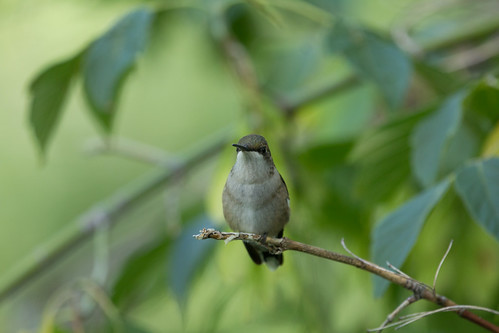 |
I don't normally take issue with scientific papers, especially those written almost three decades ago. But this particular paper, written by Miller and Gass (of Yale and the
University of British Columbia), and titled “Survivorship in Hummingbirds: Is
Predation Important?” has been quoted extensively in the literature since its
1985 publication in The Auk, despite some papers since then taking issue with the conclusions. Even the Ruby-throated Hummingbird entry in The Birds of North America Online (BNA), published and kept up to date by the American Ornithologists’ Union and the Cornell Lab of Ornithology, refers to it even as it cites several cases of predation not mentioned in it.
I started looking specifically at this paper after reading a chapter about hummingbirds in a best-selling book published just this year, The Thing with Feathers: The Surprising Lives of Birds and What They Reveal about Being Human. Noah Strycker, the author, quotes extensively and unquestioningly from the original paper, so I tracked it down to see whether I was misremembering, and maybe it was better than my vague lingering impression. But no, in fact it was even worse.
The authors really did claim to have done a thorough search
of the literature and really did claim to have been able to find only 13 cases
ever of predators attacking hummingbirds in North America as of 1985. But just using my home references and a quick search of the Internet, I found several reports of predation on hummingbirds published before 1985 that they
didn’t include. And even worse, in the case of at least one paper, they seem to have read no further than the title.
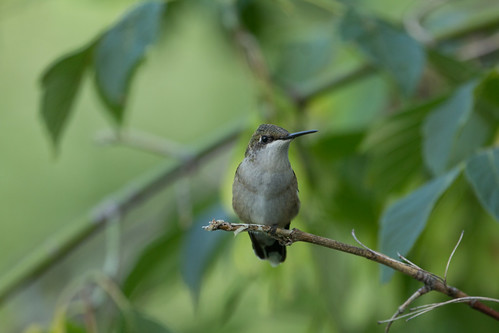 |
Miller and Gass cite a 1976 paper in The Condor by Sally Spofford titled
“Roadrunner Catches Hummingbird in Flight,” in which she discusses a case she
witnessed of a Greater Roadrunner grabbing a Black-chinned Hummingbird in
mid-air at her Arizona feeder. That accounts for the single case of roadrunner predation cited in Miller and Gass, but Spofford also wrote, in the same brief paper, that on another occasion, she had
seen a roadrunner pounding a black-chinned hummer to death on the ground, though
she didn’t know whether that one had captured it in mid-air or not, and wrote
that she’d found the tail feathers of a Blue-throated Hummingbird female that
had been ripped out by a roadrunner—in that case, the little bird got away and she
had seen it without its tail feathers afterwards. Of their 13 cases of predation, Miller and Gass cite only one case ever of roadrunner predation on
hummers. Their omission of two cases in the very paper they
cite makes their total off by 15 percent—a serious error that should have been picked up in the peer review
process and corrected before publication.
But it also begs the question why the authors believed that
a literature search could possibly include every case of predation on hummingbirds in
the first place. Back in 1982 when Russ and I birded in Arizona, I remember
people saying that roadrunners were known to snap up hummingbirds, and every
account I’ve ever read about roadrunners, including those published before
1985, mentioned that they feed on small birds. It was common
knowledge. Sally Spofford’s paper made it into a major journal
simply because she had observed a roadrunner flying off her roof to
take a hummingbird while both birds were in flight, rather than snapping at it while the roadrunner was perched or on the ground. That technique of
roadrunner predation hadn’t been known before. Now, of course, thanks to email
and the Internet, along with citizen science projects, we’ve got a lot more
easy access to sightings of predation, at least for backyard birds, than was
possible for Miller and Gass. The Birds of North America Online's entry for the Greater Roadrunner states “Frequently ambush hummingbirds
at feeders.” I’ve read accounts from many people in the Southwest who’ve had to
take in their hummingbird feeders because roadrunners were snapping up their
hummers.
 |
Cases of predation on hummingbirds by insects and frogs were
completely dismissed by Miller and Gass as “unusual or even bizarre,” although
of the 13 cases they cite in their own paper, 6—almost half—are by
insects and frogs. Ruby-throated Hummingbirds often feed on jewelweed at the
edge of ponds and streams, so it isn’t surprising that sometimes a frog grabs one. In one of his Hilton Pond reports from 2007, Bill Hilton, Jr., wrote about watching a frog leap at but miss a
hummingbird.
With regard to insects, again, it was easy for me to find cases in the literature from well before 1985. In his Audubon Society Encyclopedia of the Birds of North America,
published 5 years before the paper, John K. Terres found three cases in the
literature of Ruby-throated Hummingbirds being taken by praying mantises—one
more than Miller and Gass found. Nowadays cases of praying mantises killing
hummingbirds are well known. My quick google search of “praying mantis and
hummingbird” found gruesome photos of at least 10 different cases of these
predatory insects feeding on hummingbirds on just the first screen of results!
That information was obviously not available to Miller and Gass, but should be
known by anyone writing about hummingbird predation in 2014.
Miller and Gass didn't mention a 1934 case cited in Bent’s Life
Histories of a Ruby-throated Hummingbird on the ground in the clutches of a
large dragonfly. Duluth’s own Pershing Hofslund had a paper published in The Loon in 1977 titled “Dragonfly attacks and
kills a Ruby-throated Hummingbird,” about another incident of that. Those cases should have been mentioned
in the 1985 paper—again, I'm surprised that this wasn't picked up in peer review. And again, nowadays it’s easy to find more cases. Bill
Hilton, Jr., shows photos of one couple that came upon a hummer pinned down by
a robber fly, already missing a round patch of feathers on its skull by the time they rescued it. (Robber flies often eat just the head contents of large prey.)
Miller and Gass don’t mention predation by fish—something
I once witnessed personally, and something cited in Bent’s Life Histories from a 1922 report by Lockwood. They also don’t
mention what The Birds of North America
Online emphasizes as the most common predator of hummingbirds near human activity, the
domestic cat.
The Thing with Feathers emphasizes that hummingbirds are immune from even bird-hunting raptors, too. “Because bite-sized hummers are so quick and light, they don’t have to worry much about hawks and other attackers.” It is indeed hard for hawks to grab a hummingbird, and the payoff is indeed less than grabbing, say, a chickadee or warbler, but then again, the payoff for catching those little songbirds is less than grabbing a Blue Jay. That hardly means a Merlin or American Kestrel will pass up a chance to snatch one of those little birds—raptors grab for anything they can. Dragonflies are just about as quick and even lighter than hummingbirds, yet are a major food source for kestrels migrating through Duluth. Frank Nicoletti published a paper in 1996 in The Loon showing how the migration of both American Kestrels and even the bigger, tougher Merlins correlates with green darner dragonfly movements at Hawk Ridge. So imagining that either species would pass on a “bite-sized hummer” is ridiculous. Miller and Gass do cite one known case of a Ruby-throated Hummingbird in the stomach contents of a Merlin—a case also reported in Arthur Cleveland Bent’s Life Histories of North American Birds. But Bent also reports a Rufous Hummingbird taken by a Merlin—yet another published incident not mentioned in Miller and Gass's paper. The Birds of North America Online cited known predation on Ruby-throated Hummingbirds by Mississippi Kite, Sharp-shinned Hawk, American Kestrel, Merlin, and Loggerhead Shrike. Bill Hilton, Jr., a hummingbird bander and recognized authority on them, also lists herons, egrets, gulls, large flycatchers, jays, tanagers, grackles, and orioles to the list of known avian predators on hummingbirds in one of his Hilton Pond reports from 2007.
Living under Hawk Ridge as I do, and having counted raptors at the Ridge and from the Lakewood Pumping Station, I’ve personally witnessed Sharp-shinned Hawks, Merlins, and American Kestrels chasing hummers several times over the years, though they zipped behind vegetation before I could see how any of the chases ended. I’ve also never seen how a chase ended when a sharpie or Merlin was chasing a warbler. I’ve occasionally seen these raptors feeding on birds, but unless I’m very close or their meal is something big like a robin or jay, it’s usually hard to identify the tiny morsels. I suspect any self-respecting Merlin could rip apart and swallow a hummingbird as they do dragonflies, on the wing. People counting migrating birds seldom have the leisure to track birds for any length of time, and it's rare to see any predation events at any time, so my never having seen dead hummers in the talons of raptors hardly indicates that it never happens.
Some researchers have accepted Miller and Gass even while noting that hummingbirds show a lot of predator avoidance behaviors. Steven L. Lima wrote in his paper, "Energy, predators and the behavior of feeding hummingbirds" published in July 1991 in Evolutionary Ecology:
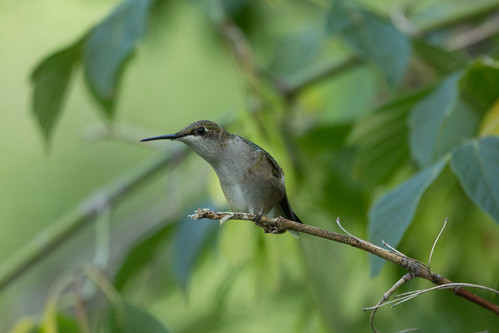 |
Living under Hawk Ridge as I do, and having counted raptors at the Ridge and from the Lakewood Pumping Station, I’ve personally witnessed Sharp-shinned Hawks, Merlins, and American Kestrels chasing hummers several times over the years, though they zipped behind vegetation before I could see how any of the chases ended. I’ve also never seen how a chase ended when a sharpie or Merlin was chasing a warbler. I’ve occasionally seen these raptors feeding on birds, but unless I’m very close or their meal is something big like a robin or jay, it’s usually hard to identify the tiny morsels. I suspect any self-respecting Merlin could rip apart and swallow a hummingbird as they do dragonflies, on the wing. People counting migrating birds seldom have the leisure to track birds for any length of time, and it's rare to see any predation events at any time, so my never having seen dead hummers in the talons of raptors hardly indicates that it never happens.
Some researchers have accepted Miller and Gass even while noting that hummingbirds show a lot of predator avoidance behaviors. Steven L. Lima wrote in his paper, "Energy, predators and the behavior of feeding hummingbirds" published in July 1991 in Evolutionary Ecology:
When Anna's hummingbirds (Calypte anna) are faced with an obstructed view of their surroundings, they engage in behaviour suggestive of anti-predatory vigilance. In doing so, they voluntarily reduce their rate of energy intake. These birds also forgo better feeding opportunities that occur close to the ground, where observations suggest they are wary of opportunistic predators such as roadrunners (Geococcys californianus). While energy-based concepts will remain useful in the study of hummingbird feeding behaviour, the lack of predation on these birds should not be equated with an insensitivity to the risk of predation.
The conclusions of Miller and Gass's paper were also specifically addressed in a paper by Zenzal and others published in 2013 in the Southeastern Naturalist, “Observations of Predation and Anti-predator Behavior of Ruby-throated Hummingbirds during Migratory Stopover.” The new paper pretty much concludes exactly what I do regarding predation during migration—that it is, indeed, one of the hazards facing migratory hummingbirds when passing over or spending time in migratory stopovers. These authors cite both cases of known predation and observations of the wariness of hummingbirds in their study areas.
 |
Miller and Gass write that “the exponential increase in
field research on hummingbirds in the last decade and the lack of a
corresponding increase in reports of predation” supports their case that
predation on hummers is exceptionally rare. But scientists should realize that for a paper to be published in a journal, it must show something
new, as Spofford's observation of the roadrunner grabbing a hummingbird on the wing did. Also, although studies of hummingbirds have, indeed, increased, studies involving killing raptors to examine their stomach contents have not only decreased—they've virtually ended. Miller and Gass's argument reminds me of the patently ridiculous argument I had to deal with back in
the 1980s when an ornithologist claimed birds were no longer being killed at
communications towers, because he’d done an exhaustive search of The Auk, and no papers had been published about it in a couple of
decades. He was clearly looking only at the titles of papers. It became
well established by the 1960s that migrating birds were being killed at towers in large
numbers at night, especially in foggy conditions, so by the 80s, that was not a publishable
new finding. Yet even in the 80s, The Auk was publishing papers in which dead birds
picked up under communications towers constituted a significant portion of data sets used to assess the timing of migration, how much body fat migrants carry, and other
issues only tangentially related to tower kills.
It would be prohibitively difficult
with the technology from 1985, or even today, to do a systematic study of
predation on hummingbirds, just like it would be prohibitively difficult to do
a systematic study of predation on, say, Bay-breasted Warblers or
Golden-crowned Kinglets, but that hardly means it makes sense to assume that predation on those species could possibly be negligible. Like loons and a few other relatively long-lived species,
hummingbirds produce only 2 eggs per clutch. And like other species with low reproduction rates, they
have developed strategies for minimizing losses to predation. A hummingbird’s size
and speed do, indeed, help it avoid being taken by predators, but its
intelligence and wariness are even more critical. A single error at a flower near where a frog is sunning, flying a bit too close to the water where a large-mouth bass happens to be near the surface, staying at a feeder a second too long as a Merlin wings by, not noticing a roadrunner lurking in a flower bed—any momentary error can be the last for any bird, including hummingbirds.
I love seeing writers referring to the scientific literature in books and magazine articles for general readers, and know that any conclusions I make from my own personal experiences can be colored by my expectations, so I try to be careful and fair when discounting any study. But really, it doesn’t make sense to base a whole chapter of a major book on a study from almost 30 years ago that has since been refuted in the literature—especially regarding birds that give us so many opportunities for personal observation and about which so much information is easily available on the Internet. There are many interesting things in the book The Thing with Feathers, but the chapter on hummingbirds is making me read the rest of it with a very large grain of salt.
I love seeing writers referring to the scientific literature in books and magazine articles for general readers, and know that any conclusions I make from my own personal experiences can be colored by my expectations, so I try to be careful and fair when discounting any study. But really, it doesn’t make sense to base a whole chapter of a major book on a study from almost 30 years ago that has since been refuted in the literature—especially regarding birds that give us so many opportunities for personal observation and about which so much information is easily available on the Internet. There are many interesting things in the book The Thing with Feathers, but the chapter on hummingbirds is making me read the rest of it with a very large grain of salt.
